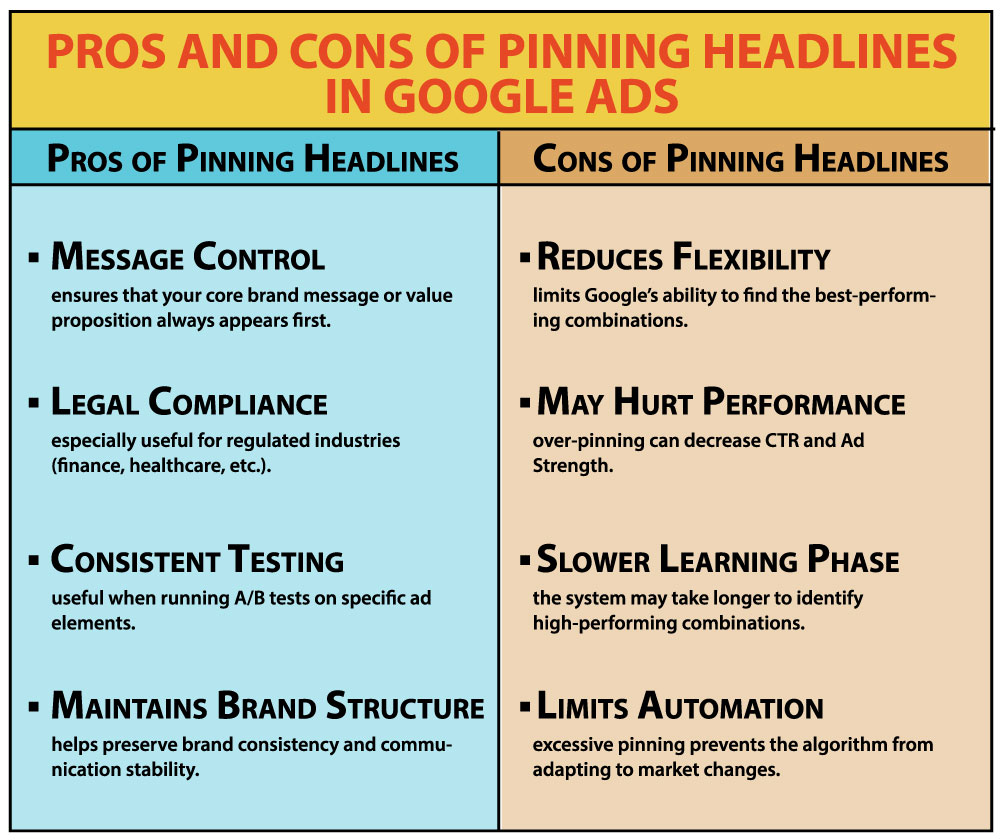Responsive Search Ads (RSAs) have become the default ad format in Google Ads. While they offer powerful automation and flexibility, they can also feel unpredictable — especially when you’re trying to maintain consistent messaging.
That’s where pinning headlines comes in.
In this guide, we’ll walk you through:
- What pinning is and how it works
- The pros and cons of using it
- When to pin headlines (and when not to)
- Strategic pinning best practices
- Real examples and results from campaign testing
What Does “Pinning” Mean in Google Ads?
In responsive search ads, you provide up to 15 headlines and 4 descriptions. Google automatically tests and rotates them to find the best-performing combinations.
Pinning allows you to control where specific headlines appear by assigning them to a fixed position (e.g. Headline 1, Headline 2, etc).
Example:
You want your brand name to always appear first. So you write:
- Headline: Official Site – ACME Tools
- Pin it to Position 1 → Google will always display it as the first headline.
This is especially useful for:
- Compliance (legal disclaimers, brand terms)
- CTA consistency (e.g. “Buy Now” always in slot 2)
- Testing static vs dynamic combinations
How to Pin Headlines in Google Ads
The pinning process is simple:
- Go to your Google Ads account → Ads & extensions
- Edit or create a Responsive Search Ad
- Hover over a headline or description field
- Click the 📌 Pin icon that appears on the right
- Choose which position to pin (e.g. Headline position 1, 2, or 3)
- Save your ad
Repeat for any other element you want to control.
You can pin multiple headlines to the same position. In that case, Google will only rotate between those pinned options in that slot.
Should You Pin Headlines? Pros and Cons
Pros of Pinning
- Message Control: Guarantees that your core value prop or brand message appears first
- Legal Compliance: Useful for industries like finance or health
- Consistent Testing: Useful when A/B testing other elements
Cons of Pinning
- Reduces Flexibility: Limits Google’s ability to optimize combinations
- May Hurt Performance: Over-pinning can decrease CTR and Ad Strength
- Slower Learning Phase: Ads may take longer to find high-performing combos
Google itself recommends minimal pinning, but in many real-world accounts, selective pinning has outperformed fully automated RSAs — especially in lead generation and regulated sectors.

Best Practices for Pinning Headlines in 2025
To pin effectively without hurting performance:
1. Pin Only What You Must
Pin brand names, legal disclaimers, or must-have CTAs. Let Google optimize the rest.
2. Use One Pinned Option Per Slot
Avoid pinning multiple headlines to the same position unless you’re actively testing them.
3. Monitor Ad Strength
Google may reduce your Ad Strength score if you over-pin. If possible, pin only 1–2 positions per ad and test performance.
4. Match CTA to Position
If your best converting CTA is “Get a Free Quote” — test pinning it in position 2 or 3, where users typically expect offers or action.
5. Always Review Performance by Asset
Google Ads reports performance per asset and combination. If pinned assets underperform, test unpinning and compare.
When to pin headlines in Google Ads: 3 strategic use cases for better performance and compliance.
Example Pinning Strategy (Lead Gen Campaign)
Goal: Get leads for a SaaS scheduling tool
Headlines (15 total):
- Pinned to position 1: Official Site – ScheduleNow
- Pinned to position 2: Start Free in Under 30 Seconds
- All other 13 headlines: unpinned
Result:
- CTR: +14% over fully unpinned ad
- Conversion rate: +8%
- Ad Strength: “Good” (vs. “Excellent” in unpinned)
Bottom line: pinning 2 slots provided message consistency without overly restricting automation.
When to Avoid Pinning
- eCommerce campaigns with product variants or offers
- Brand awareness campaigns with broader themes
- Short-term testing when you want to give Google full control
If performance is volatile, test a version without pins and compare. Sometimes, fully unpinned RSAs perform best when Google has enough data.
Final Thoughts: Control vs. Performance
Pinning in Google Ads is a strategic lever — not a rule. Used wisely, it allows you to:
- Reinforce brand identity
- Improve clarity in competitive markets
- Maintain compliance where required
But like any constraint in machine learning systems, it can reduce flexibility and results if overused.
If your campaigns rely on consistent structure, messaging, or regulated language, then pinning is essential. If your goal is maximum performance at scale, consider using it sparingly.
Work with 3MY: Smarter Google Ads. Better Results.
At 3MY, we don’t just launch Google Ads — we design conversion-driven ad systems.
When we run RSAs, we:
- Plan structured headlines around user intent
- Pin critical assets to test message control vs algorithm freedom
- Split test pinned vs unpinned variants
- Optimize for CPL, CTR, and qualified lead rate
Whether you need to stabilize ad delivery or increase ad compliance — we’ve built pinning frameworks that deliver.
[Book a Free Google Ads Audit →]










